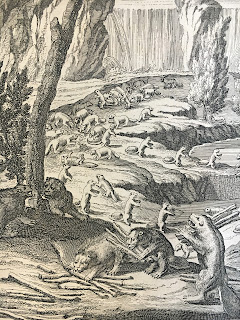 |
| "A View of Industry of the Beavers of Canada in making Dams to stop the Course of a Rivulet..." |
Herman Moll (1654?-1732) was a London-based cartographer famed for his accuracy. The "Beaver Map" is one of the first to show the extent of British settlement and colonization in North America after the Treaty of Utrecht in 1713 -- and Moll claims a bit more for the British than the French would have liked.

The map's fame comes from the large engraving of beavers working near Niagara Falls (detail to the left). The beavers are seen gathering sticks in their arms and carrying rocks and mud on their tails -- an allegory for British colonization and the hard work of taming the wild North American landscape (and destroying extant civilizations). The beavers look a bit like lions or bears, but both their appearance and curiously human traits would have been unknown to a European audience. It turns out that Moll copied the beaver scene from a French cartographer, Nicolas de Fer (1646-1720), who included a very similar engraving on a map in 1698.
Our "Beaver Map" is contained in a version of The World Described : or, a New and Correct Sett of Maps: Shewing the Several Empires, Kingdoms, Republics...in all the Known Parts of the Earth seems to be an amalgamated edition of maps produced between 1709 and 1720. Each map is a different size when unfolded. For the map nerds out there, it also contains two Ortelius maps.
 |
| A beaver casualty |
https://en.wikipedia.org/wiki/European_Beaver
ReplyDeleteGood point! So then the question becomes -- if the Europeans already knew about beavers, why do the beavers pictured in Moll's map not look like the Eurasian/European beaver?
DeleteHerman Moll never saw a beaver; he drew them from second-hand descriptions.
ReplyDelete